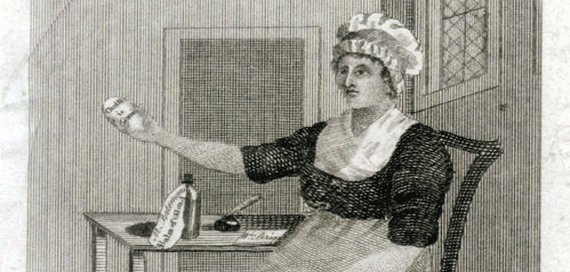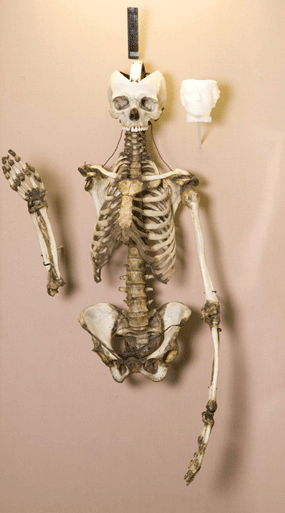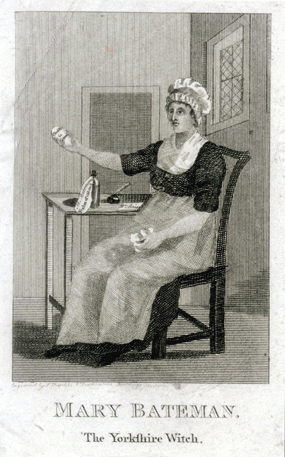Mary Bateman: The Leeds Witch

Keith Spence looks at the case of Mary Bateman, the notorious ‘Yorkshire Witch’, who was tried and executed for witchcraft two centuries years ago.
Two hundred years ago a trial as sensational as any before or since rocked Yorkshire. The trial and execution of the Leeds Witch – Mary Bateman – took place at York Castle in 1809 but, even today, her story still grips the hearts and minds of Yorkshire people.
This summer children and adults have been flocking to Thackray Medical Museum in Leeds to listen to stories about the infamous witch and view her skeleton in the galleries of a Victorian street.
Mary Bateman’s story is an epic one of murder and witchcraft. She was responsible for numerous frauds, petty thefts, poisonings and deaths in the late 1700s and early 1800s. She was hanged at York Castle on March 20, 1809. When her body went on display more than 2,500 came to see it.
Perhaps one of the most wicked women in criminal history, she brought terror to innocent people through her witchcraft, and ruined the lives of gullible victims.
“Sending her victims into trances”
 She was born at Aisenby, near Thirsk, the daughter of a farmer and his wife and in her formative years mixed with gypsies. Aged 20, she turned up in Leeds and worked as a dressmaker but made most of her money in a profitable sideline – telling fortunes. She became bolder and more outrageous as the years passed, living for the next 20 years a life of continuing crime and deception.
She was born at Aisenby, near Thirsk, the daughter of a farmer and his wife and in her formative years mixed with gypsies. Aged 20, she turned up in Leeds and worked as a dressmaker but made most of her money in a profitable sideline – telling fortunes. She became bolder and more outrageous as the years passed, living for the next 20 years a life of continuing crime and deception.
After a courtship of only three weeks, in 1793 she married John Bateman, a simple wheelwright, but he soon regretted this hasty arrangement when he found she was deceiving and stealing from fellow lodgers. He was hoodwinked into believing his father, the Thirsk town crier, was seriously ill and while he was away seeing him, his wife sold his clothes and furniture to repay victims who were threatening her.
She practised fraud and deception on a grand scale, seemingly sending her victims into trances. She roamed the streets of Leeds after a major fire begging for money and goods for victims, but they all ended up in her home.
“Christ is coming!”
She claimed, notoriously, that she had supernatural skills: a woman believed her husband was in jail and would be sentenced to death. Bateman told her she would save her from this disaster for four pieces of gold. Another woman was tricked into believing her husband was having an affair and gave everything to Bateman, who promised to stop the disaster.
She was known throughout Leeds as a fortune teller who could ward off evil spirits. Within months after her marriage, she carried out many frauds and only escaped prosecution by moving from place to place. Her husband, driven wild by the tricks of his wife, joined the army and she was left to her own devices to deal in fortune telling and selling charms.
She had acquired a manner and speech which completely fit her chosen career and, daily, credulous victims called on her only to be duped by heartless and cunning schemes. One of her deceptions involved a hen that laid eggs bearing the words ‘Christ is coming’. She charged a penny to see them. Her husband eventually returned from the forces and apparently shared the proceeds of his wife’s villainy.
“Pudding laced with poison”
 Meanwhile, Bateman got too ambitious and turned to murder. Two Quaker sisters who kept a draper’s shop died mysteriously along with their mother. They had taken medicines prescribed by Bateman, who stripped the house. She told the neighbours they had died of the plague. A good deal of luck and cunning enabled Bateman to escape the law. Her name had become celebrated in the Bramley district for her successes in the arts of divining and witchcraft. She was frequently asked to work cures on “evil wishes” and imaginary illnesses to which the humble believed they were liable.
Meanwhile, Bateman got too ambitious and turned to murder. Two Quaker sisters who kept a draper’s shop died mysteriously along with their mother. They had taken medicines prescribed by Bateman, who stripped the house. She told the neighbours they had died of the plague. A good deal of luck and cunning enabled Bateman to escape the law. Her name had become celebrated in the Bramley district for her successes in the arts of divining and witchcraft. She was frequently asked to work cures on “evil wishes” and imaginary illnesses to which the humble believed they were liable.
The case that led to her downfall and to the gallows involved Rebecca Perigo. She believed she was possessed with an evil spirit and asked Bateman to get rid of it. Bateman said she would sew four guinea notes in her bed and she was to get four golden guineas to replace them. Money and gifts changed hands. When suspicions were roused Bateman began feeding Rebecca and her husband, William, with pudding laced with poison. William survived but Rebecca died in agony.
Two years later William decided to recover the guineas sewn into his bed but discovered they were cabbage leaves. He realised he had been duped and arranged a meeting with Mary Bateman, at which she was arrested. Although she proclaimed her innocence, a search of her home turned up poison as well as belongings of her victims, including the Perigo couple.
“Cured cuts of her skin”
Her sensational trial of the murder of Rebecca Perigo took place at York Castle on Friday, March 17, 1809. It doesn’t take the jury long to find her guilty. But to the end she uses her guile to try to escape being hanged. She claims she is pregnant. At this time it is illegal for a woman at an advanced state of pregnancy to be hanged. However, an examination by matrons find that, once again, she is being untruthful. Her deception doesn’t stop in jail. She persuades a fellow prisoner to part with cash in return for a charm.
At her trial, she admits to fraud but denies murder. Three days after her conviction she is hanged at York Castle before a crowd of thousands. People subsequently pay to see her corpse which is handed over to Leeds Infirmary for dissection. They also pay to get cured cuts of her skin as charms.
The skeleton is now on loan to the Thackray Medical Museum from Leeds University Medical School. It still attracts great interest. Amy Horton, Assistant Learning Officer at the museum says: “It is one of our iconic items. This small skeleton hanging in a Victorian Street grips the imagination of visitors to the museum. The folk law has probably been embellished over time. But there is no doubt she was a nasty piece of work.”
The award-winning Thackray Museum is one of the UK’s leading medical museums. It tells the story of medicine and explains how advances are changing our lives.
The Museum is open daily from 10 am to 5 pm. It closes on 24 – 26 and 31st December and 1st January.
Thackray Museum, Beckett Street, Leeds, LS9 7LN. Telephone 0113 2444343.










Her crimes were bad, but the desecration and exploitation of her body was despicable! Those people were criminals, too.
Mary Bateman is my 5th Grandmother. I’ve known of her story since my youth, as my ancestry comes from Kirkgate and the surrounding area. A shock when I discovered this while tracing my ancestry.
I just found out yesterday that Mary Bateman was my 5th great grandmother–and it was shocker for me, too!
I have just found out that mary Bateman is my Great Great Great Great Great Grandmother….shocker.